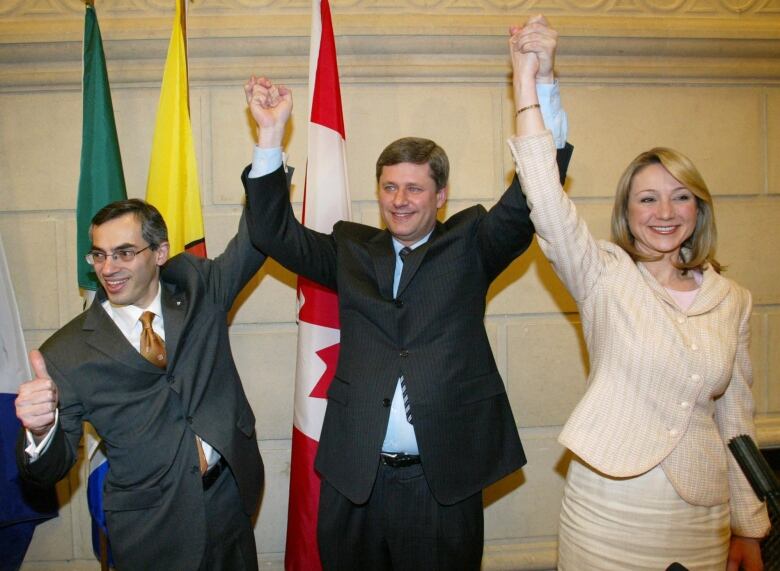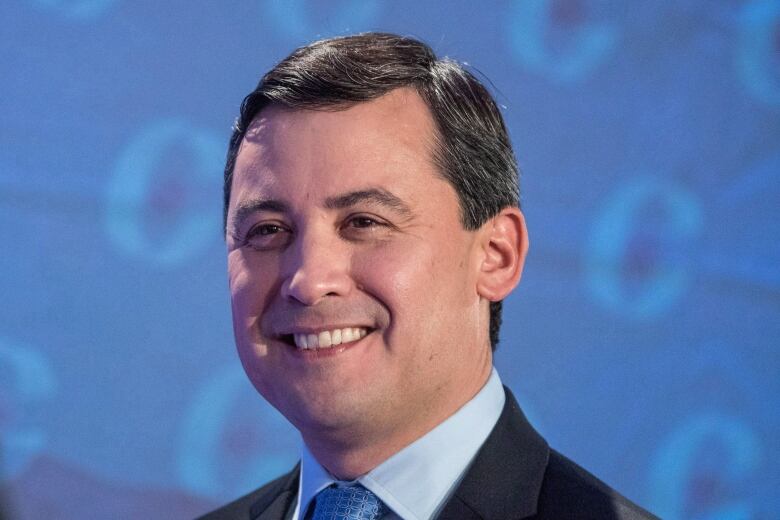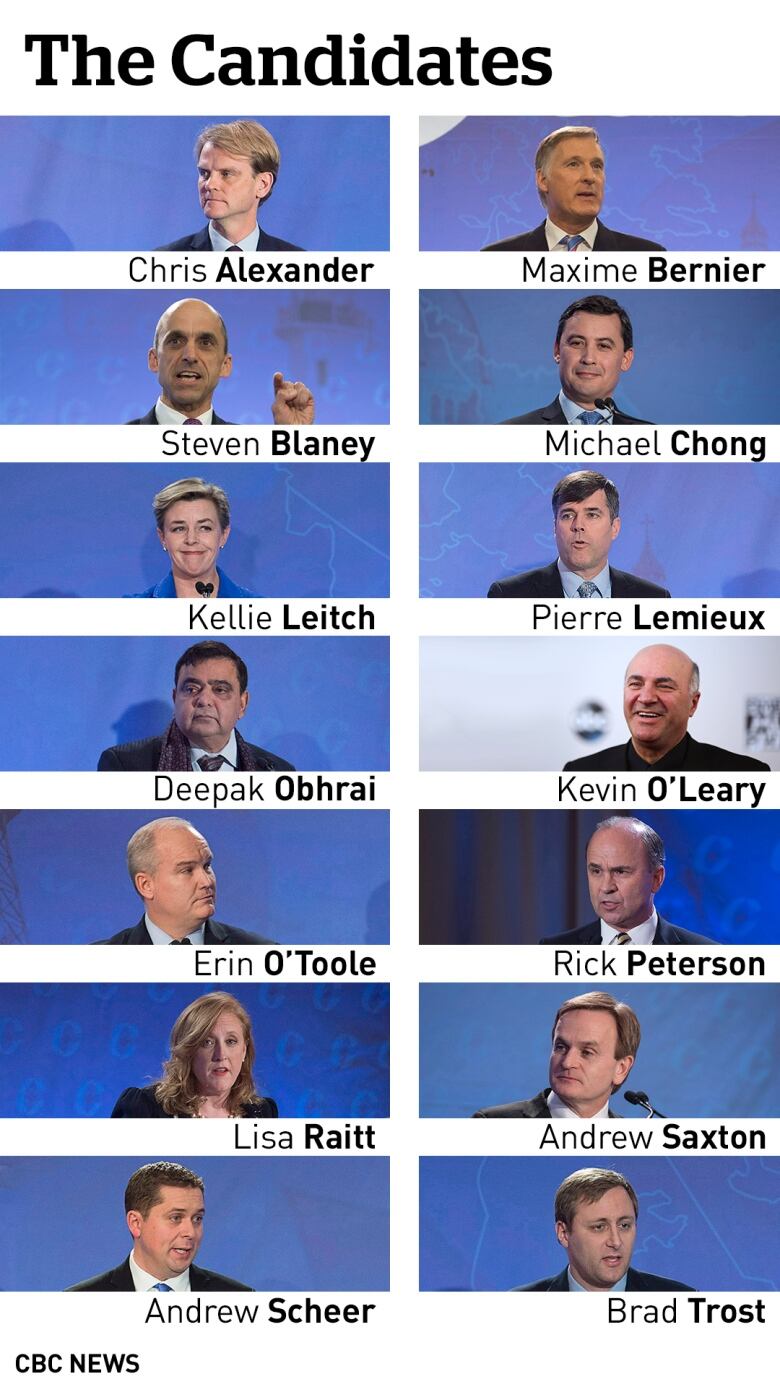Conservative memberships likely down from 2004 leadership race despite larger field
Voting for the next Conservative leader isn't free - should it be?

With 14 candidates in the Conservative leadership race trying to attract new supporters,the party's membership rollhasthe potential to be larger than ever. But so far, it seems the number of people eligible to vote in May will be smaller than when the party picked Stephen Harper as leader in 2004.
"There (are) going to be fewer memberships sold in this membership race compared to 2004," candidate Michael Chongsaid last week at the party's caucus meeting in Quebec City.And he's not alone in this assessment.
Why?
In 2004, the Conservative Party was new. It had just merged the lists of its legacy parties, the Progressive Conservative party and the Canadian Alliance (previously the Reform Party.) Over250,000 members were eligible to vote.

"Canadians were quite upset with the Liberal government of the day because of the [sponsorship] scandal," Chong said. "There was an incentive for people to join the Conservative Party to get rid of the Liberal government."
Today, it's different. Conservatives just spent a decadein power, with all the bumps and knocks that brings.
Party estimatestallythe current membership at just over 100,000. This figure is growing, as lapsedmembers renew to voteand candidates' teams sign up newsupporters.
But Chongsaidhe'll be surprised if there are 150,000 eligible voters on May 27 when the party picks its new leader. That figure might be a bit conservative, but no one CBC News spoke to expects much more.
$15 to join
Controversy erupted last year over the party's decision to hike annual membership fees to $25 from $15.
Jason Kenneywho considered running for the federal leadership before deciding to run for the Alberta Progressive Conservative leadership instead and Deepak Obhrai, who did join the race, were among the loudest voices calling the fee hike a disincentive.
The party relented. The feeis still $15.
But something else has changed.
Candidatesare no longer free to sign up and pay for large blocks of new members using campaign funds. Individuals have to buy their own membership using a credit card or cheque.

"It's comparatively difficult to sign up people," said Tony Clement, once a candidate himself butnow working on MaximeBernier'steam.
"If you're doing a phone bank ...your next question is great, give me, a stranger, your credit card information so I can get yousigned up. It's not going to happen."
Clement calledthe rules "impediments to massive signups."
Candidate Andrew Scheerdoesn't mind them, arguing they protectthe integrity of the race by preventing the shenanigans of Tory races past.
When someone buys a $15 membership, the party "can count on that person to help in an election, show up at events, to make donations down the road," he said.
Scheer'sfocusing onfinding local activists who know how to organize and work networks to sell memberships to motivated supporters.

"It is a challenge. It's a big country," he said. Plus,every riding counts equally: winning ariding with only a few dozen members is as valuable asone withthousands.
Liberals vote for free
The Liberal Party had a different strategy when itelected Justin Trudeauleader in 2013.
A free "supporter" category helped add more than 130,000 new eligible voters, swelling party ranksto over 300,000.
Just over one-third voted, comparable to the 37 per cent turnout Conservatives had in 2004.

If only one-third cast a leadership ballot in 2017, as few as50,000 Conservativesspread across 338 ridings will have decided the race.
ChongsaysLiberals got ahead of the curve.
My vision is of a party that has a million members. Aparty that has much greater public participation.- Michael Chong, Conservative Partyleadership candidate
"Things have changed a lot in the last 10 years," he said. "Increasingly, Canadiansare unwilling to pay a membership fee to join a political party. Just like they're not willing to pay a membership fee to sign up to Facebook or have a Gmail account or to sign up to Twitter."
Chong wishes the party would ditch membership fees and create a permanent registry instead, perhaps througha tick box on federal tax returns.
"My vision is of a party that has a million members," he said. "Aparty that has much greater public participation."
Deadlinessoon
After the end of February, a $5 charge applies for memberships submitted up to the final March 28 deadline.
That means if a candidate sells 10,000 memberships in the home stretch, he or she will have to fundraise$50,000 more.
(As an incentive, the party paidcampaigns $5 for each membership soldbefore October.)
Which brings us to Kevin O'Leary, who joined the race Jan.18 promising to draw on the support of 40,000 people urginghim to run.

Spokesman Ari Laskindidn't offerCBC News specific numbersbut said there was "a real surge of membership purchases on our website."
Earlier this week, O'Learytold The Canadian Press he'ssigned up9,000.
He may be the first choice of some existing members.If he isn't,he's got a long way to get over the 50 per cent threshold to win.
"He's starting late, and he'll have his work cut out for him,"Scheersaid.
Chong, Kellie Leitch andfundraising front-runner Maxime Bernier startedselling memberships last spring.
"O'Learyhas stated that he's going to be relying on the hundreds of thousands of people who follow him on Twitter or Instagram to be sign-ups. A lot of those people are Americans," Clement said.
This is not the system that elected Donald Trump, he warned.
"We don't have a primary system where each province is deciding on a different day and someone can gain momentum," Clement said. "No one knows how other people are voting until after the votes are counted.
"He should be able to sign up some members. Whether that'senough to win the race is an open question that we'll all be experts about after it happens."













_(720p).jpg)


 OFFICIAL HD MUSIC VIDEO.jpg)
.jpg)



























































































